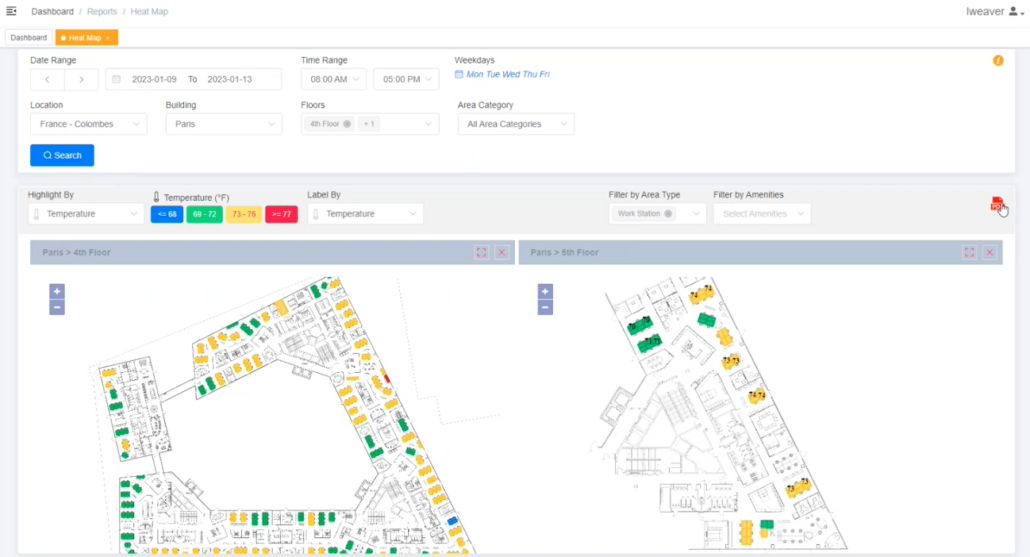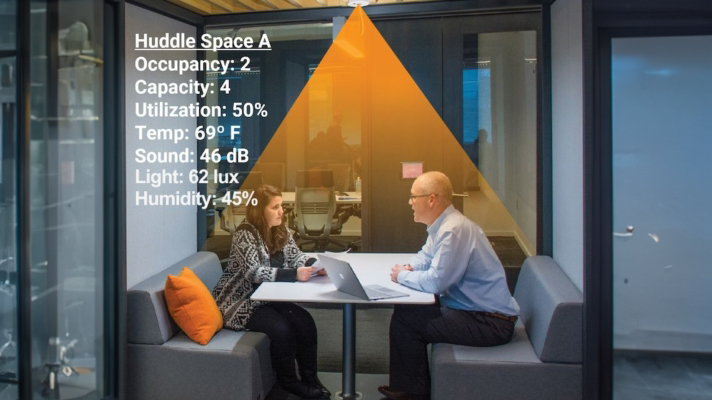Occupancy sensors are rapidly changing the way companies think about real estate and the workforce. These small but mighty sensors do more than you might think: there is a wealth of data that can be measured with occupancy sensors that can help corporate real estate executives make better decisions that impact both CRE metrics and the company’s overall bottom line.
What Do Occupancy Sensors Primarily Measure?
Occupancy sensors (or vacancy sensors) are primarily designed to detect the presence of people in the room, while maintaining anonymity and privacy. However, when paired with a workplace analytics platform, CRE Executives can both visualize data at a high-level and zoom in to see more granular data. Here is a list of ways you can look at the data:
- Overall utilization rates at a global scale or entire portfolio
- Office utilization rates in a specific city
- Office utilization rates in a specific site or building
- Utilization of a specific floor
- Usage of specific space types like conference rooms, phone booths or special rooms
- Usage of a specific area of the room, such as a break station or lounge area
- Usage of an individual desk or workstation
What Else Can Occupancy Sensors Measure?
Some occupancy sensors, such as the VuAI are equipped to measure much more than just utilization rates, and can even tie into building management systems. Here are a few more things that can be measured:
- Temperature
- Light
- Noise
- Humidity
CRE executives might immediately think of the energy savings from monitoring environmental factors, but the impact on employee comfort is just as important. If a space is uncomfortable or lacks the right technology, that can explain why employees aren’t using it. Modifying or eliminating this space can have a great impact on the business.
What Can You Do With This Data?
Corporate real estate professionals can use data from them to make better decisions about their offices and real estate. Here are just a few use cases:
- Leasing decisions
- Back to office or hybrid work policy decisions (read our case study on this)
- Rightsizing
- New build outs
- Redesigns or modifications of existing space
- Where to invest in technology
- Where to add or remove office or building amenities
What Metrics Does This Data Impact?
These metrics can have a important impact on:
- Corporate real estate assets or liabilities on the balance sheet
- R&M and Building Maintenance line-items on the P&L statement, including cost of utilities and cost of cleaning (read our case study here)
- Cost per square foot
- Cost per head/seat
- Office utilization rates
- Employee retention rates
- Employee wellness and satisfaction
- Employee productivity
- Capacity
- Density
- Attendance
- Mobility ratios
- Overall bottom line
How Accurate Is The Data?
There are five spatio-temporal properties of occupancy sensors (Teixeria, et al, 2010). Sensors that can detect all five behaviors are more accurate. The behaviors are organized in a hierarchy according to the amount of data needed to process them. From least to most, the properties are:
- Presence – Is there at least one person there?
- Count – How many people are present?
- Location – Where is each person?
- Track – Where was this person before?
- Identity – Who is each person?

The accuracy of occupancy sensors depends on the type of sensor, the brand, and how they were installed. PIR motion sensors are the least accurate type, because they do not detect passive occupancy or the specific location of a person in the room. They also have limited range, and if installed in the wrong location, may lead to inaccurate data. However, pairing them with other types of sensors can make them more accurate.
Optical sensors are the most accurate type of sensor. For example VuAI is over 98% accurate, and uses machine learning to analyze occupancy data.
How Can You Visualize Data From Occupancy Sensors?

Data is meaningless unless you can make sense of it. The best sensors are paired with workplace visualization platforms that allow CRE professionals to create custom, visual data reports at every level of the portfolio. VuSpace allows you to visualize data with:
- Heatmaps
- Real-time dashboards
- Booking maps
- Occupancy reports
- Predictive reports
- Excel exports
- PDF exports
- And more
Are There Privacy Concerns With The Data Measured?
Optical sensors do not identify individuals’ faces or personal information. That said, it is crucial for organizations to maintain transparency about the data collected and its usage, ensuring that employees understand that the primary goal is to improve workplace conditions rather than monitor individual performance. It’s important to emphasize that these sensors can significantly enhance workplace comfort and efficiency.
What Will Occupancy Sensors Measure In The Future?
Advancements in artificial intelligence and machine learning are expected to greatly enhance the functionality of these sensors – in fact it’s already being used in AVUITY sensors. In the coming years, we may see occupancy sensors that are not only more accurate and efficient but also capable of measuring a wider range of environmental and behavioral parameters. For instance, sensors could evolve to analyze air quality, detect varying levels of light and sound conducive to optimal working conditions, or even monitor the emotional state of occupants. The integration of biometric data, such as heart rate or stress levels, may also become feasible, offering unprecedented insights into workplace wellness. However, there are privacy and ethical concerns associated with this type of data. As smart building technologies mature, occupancy sensors could play a pivotal role in adaptive environments, where spaces automatically adjust lighting, temperature, and even physical layouts in real-time, responding to the immediate needs and preferences of their occupants.
Key Takeaways:
Occupancy sensors are not just “people counters”. They measure much more than just vacancy, and allow CRE executives to visualize data and make better decisions that can positively impact all areas of the corporation. Optical sensors such as VuAI are extremely accurate. The introduction of such technology can alter work habits, leading to a more data-driven approach to workspace utilization and efficiency.


